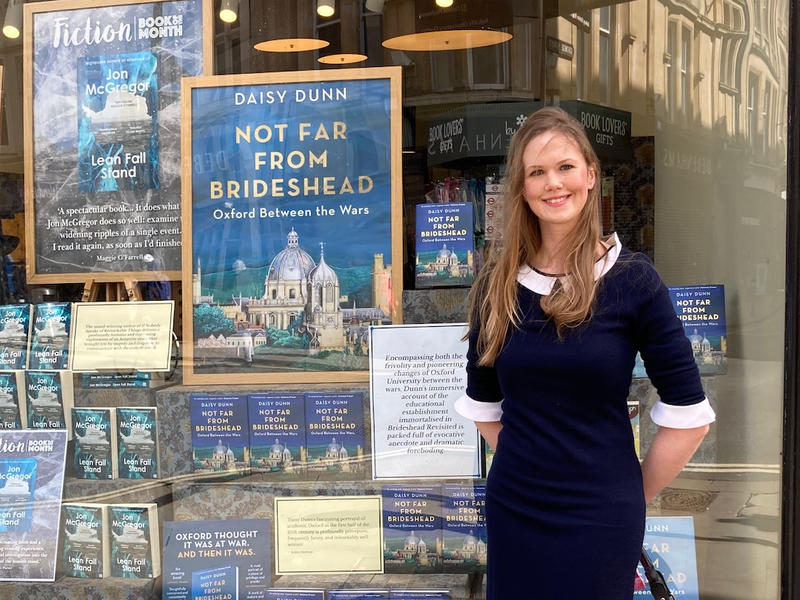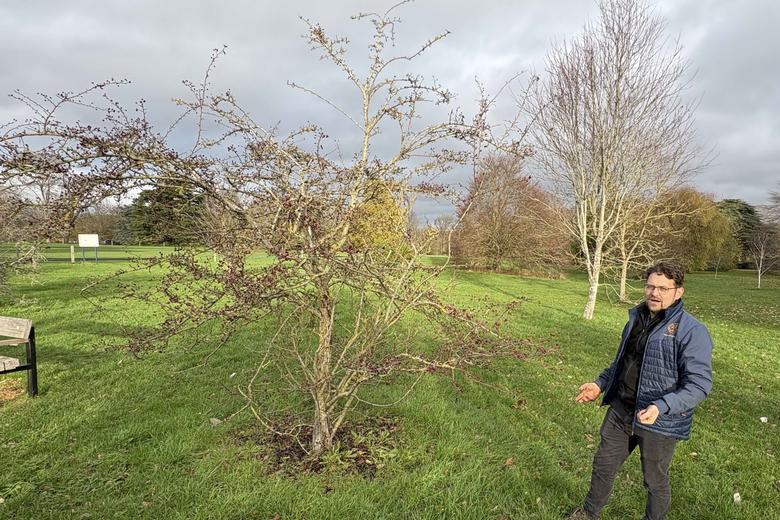NOT FAR FROM BRIDESHEAD

NOT FAR FROM BRIDESHEAD
A remarkable new book brings Oxford between the two world wars back to life again
Published: 17 May 2022
Author: Richard Lofthouse
Share this article

Not far from Brideshead, Oxford Between the Wars by Daisy Dunn (Weidenfeld and Nicolson, 2022).
The author of this highly original, poignant account of Oxford between the two World Wars, Daisy Dunn (St Hilda’s, 2005 - pictured above) is an accomplished classicist and historian, her last book In Shadow of Vesuvius, a Life of Pliny (2019).
Naturally, she read classics at Oxford.
Daisy’s training is of great significance because Not Far From Brideshead is centrally about classicists and three in particular – E.R. Dodds (Univ, 1912); Maurice Bowra (New College, 1919) and overarching both like a great Victorian buttress, their mentor the Regius Professor of Greek from 1908, Gilbert Murray (St John’s, 1884).
Classics, or Greats as it is also known, was the queen subject at Oxford and commanded huge academic weight spilling over into public discourse. Daisy is able to unpack that through her own extensive knowledge, a valuable bridge to the past but also a translator for those of us who don’t have Greek and Latin.
You certainly don’t need to be a classicist to enjoy this book. Moreover, the extended cast includes some of the most brilliant writers and thinkers of the twentieth century: John Betjeman, Vera Brittain, Iris Murdoch, Virginia Woolf, Cecil Day Lewis, Kenneth Clark, W. H. Auden, T. S. Eliot, Louis MacNeice, C. S. Lewis, W. B. Yeats, Henry Green, Elizabeth Longford and Edith Sitwell.
Not seeing them all through the centrifuge of Bloomsbury is a relief. Dunn relates them instead to the immediate Oxford environment, to the inter-war years and to their subject matter, so important considering the extent to which scholars can find themselves living dual lives, in their own present with copies of newspapers and High Table gossip on the one hand, on the other heads crammed with the atmosphere and events of an entirely different historical era.
We learn very quickly just how badly the Great War did for Oxford, killing or maiming a high number of its most promising scholars. When some of the men returned, alive, to take up scholarships that should have begun in 1914, Maurice Bowra among them, it was with a degree of throwaway cynicism crossed with mad exuberance or simply wanting Oxford to be a bolthole. Behaviour ranged from evident post-traumatic stress disorder, undiagnosed, perhaps masked by learning; to plain old aristocratic violence throwing chairs around and burning them in some quads.
Bowra had a very brutal war, and it was a miracle that he survived. He was of the view, common in 1919, that the peace wouldn’t hold and that there was a high chance that he would be back in fatigues soon.
That insight is very refreshing but the broader reason for it, and perhaps why we encounter it so little in other histories, is that the classicists all had in mind the Peloponnesian War, or as Daisy puts it in a conversation with QUAD, ‘the first world war in the sense that it involved all the City States and completely overturned history, catapulting Athens from being at the top to being at the bottom – a catastrophe.’
The further extraordinary insight is that while Bowra’s generation may have been wrong about going back to the Western Front in the very short term, their Peloponnesian example was otherwise spot on – the fight with Sparta taking 25 years (431-404BC) while war with Germany resumed after 21.
The ‘interwar years’ as they have too conveniently familiar, are brought fully to life by Daisy as the unsteady, crisis-fatigued lurch from one thing to the next domestically and internationally – as a cessation of hostilities rather than a peace.
The degree to which Murray, originally Australian and also a political figure with a large public profile, campaigned for peace and dreaded war throughout his life, shown very well by Daisy, is almost evidence for the extent to which his better nature knew that the world was sliding back into trouble again.
So strongly did he intuit this, that Murray delivered a lecture on the Peloponnesian War as a parallel to the Great War, in London in November 1918, which by then had a Spanish Flu in the mix and thus a curiously current feel to it seen from 2022.
Dunn writes, ‘If prewar Britain was pre-Periclean Athens, then postwar, influenza-ravaged Britain resembled the Greek city-state after the Peloponnesian War and its accompanying plague.’
In his lecture Murray compared Germany to Sparta and both the Peloponnesian War and the Great War, he argued, ‘startled the world by [their] uncompromising ferocity.’
Daisy notes how in a strange sense we’ve had a pandemic followed by war in Ukraine, also startling in its ferocity, while the generation of the Great War had a war followed by a pandemic. A reversal.
In both cases there was desperate government spending followed by steep inflation, populism and broader concerns about wider conflagrations. The National Strike is well covered here, so too the day Oswald Mosley brought his henchmen to Oxford; and so too the Wall Street Crash.
The book is brilliantly un-stuffy without trying to follow any agenda. We get a super chapter on Birmingham where Dodds headed off to teach.
Women get full inclusion too, despite the leading characters being men, and there are rare photos of sizzling characters like Rimbaud scholar Enid Starkie (Somerville, 1916) and Elizabeth Harman (LMH, 1925), powerful, brilliant women in their own right and exemplars of the better nature of Oxford as it slowly (far too slowly, yes) got its head around inclusion and diversity.
The core drama that drives the narrative is the moment in 1936 when Maurice Bowra didn’t get the Regius Chair in Greek when Murray retired, but Dodds did.
This caused an uproar that spilled well beyond Oxford. ‘Had Maurice Bowra, a revered scholar, Oxford man and veteran of the trenches, really been passed over in favour of an obscure Irish ‘conchie’ from Birmingham?’
Fur flew and blood was spilt. Only Dodds comes out of it well. Oxford does not come out of it well. It’s a great read.
But the cumulative genius of the book is arguably less to do with these narrative fireworks than how the peculiar shape shifting of culture, politics, current affairs and personality reveal rapid change within Oxford and beyond, from frothy 20s to sober 30s, shedding a peculiar and disconcerting light on our own times.
Virginia Woolf wrote privately in her diary how she had devoured Vera Brittain’s Testament of Youth, published only in August 1933 even though we all know it’s about the Great War and a lost love.
Woolf summarised, ‘A very good book of its sort. The new sort, the hard anguished sort, that the young write; that I could never write.’
That was the Great War surfacing like an ugly monster, years after the event, perhaps just as right now in 2022 no publisher wants another book about the pandemic but down the road one can imagine it re-surfacing, differently.
Culture is like an individual. It favours repression at some turns and expression at others, time being the main point of arbitration.
How rapidly in Not far from Brideshead the atmosphere curdles around and after the Wall Street Crash, and then into house building, precinct-modernism and appeasement, sliding into international calamity again just as everyone thought it impossible.
By 1938, Dunn reminds us, ‘Conversation at Oxford turned on Nazism, Franco’s victories in Spain, the Jews, fascism. Students, anticipating war at any moment, congregated in Christ Church Meadow to put on a play entitled It Can Happen Here.’
We then hear about senior Nazi authorities who came to Oxford as a delegation to hector senior University members with pre-written speeches insisting that England and Germany were friends who should combine to fight the Russian ‘menace.’
A few weeks hence, news came of the Nazi-Soviet non-aggression pact which is eerily similar to the Russia-China joint statement published on February 4, 2022, which shortly predated the Russian invasion of Ukraine.
Not far from Brideshead is not written with the present in mind. It is strictly a work of history. But the present comes alive when you read it, and that overwhelming sense that history doesn’t repeat itself but there are strong echoes, sometimes deafening.
It is also poignant at the individual level. Bowra’s force of personality was compared to a Roman emperor; his gossipy malevolence legendary. He magnetized Oxford but he was punished in equal measure, passed over for any meaningful role in World War Two and unlike, say, John Maynard Keynes, not given the benefit of doubt on his sexuality and (also unlike Keynes) refused to marry for the sake of appearances.
He was to a degree tortured while in other regards refused to play ball. By the standards of his generation he was highly productive as a scholar.
Some of his malevolent doggerel is reproduced by Dunn and it is a merciful relief of comedy amid Oxford’s typical ocean of seriousness.
Like her subjects, Dunn says that she nurtures her own cause to advocate for the fine ideals of the Ancient Greeks, but the origin of the book was by chance not by design, she recalls.
She happened to be in Yorkshire speaking at a Literary Festival in 2016 and ‘decided on a whim to visit Castle Howard’, which remains open to the public and was an inspiration for Evelyn Waugh’s original Brideshead Revisited.
She was struck by how much classical art was hanging in the house and knew that Gilbert Murray had married into the Howard family.
It led to fierce research, 85% of which was completed before the first lock down of 2020, the rest she says resulting from brilliant and generous archivists helping her from within the Bodleian Library and several Oxford colleges.
Several of the figures in Daisy’s narrative were also inspirations for characters in Waugh’s, not least Bowra, so the title of the book is by no means a marketing ploy. And Oxford was a very different university before and after 1939-45, and since; not least in its sheer size which ballooned after 1945 and would today amaze the pre-war generation.
But the ultimate effect of Dunn’s historical group portrait takes us far away from ‘Brideshead’, if by that we mean a lazy cliché of privilege and bad behaviour, which it wasn’t quite even in the original book by Waugh, too often unread.
Daisy will be discussing her book at Meeting Minds on Saturday 17 September 2022 at 3pm (BST).
Book your Meeting Minds ticket to join this in-person event at St Hilda's College.















